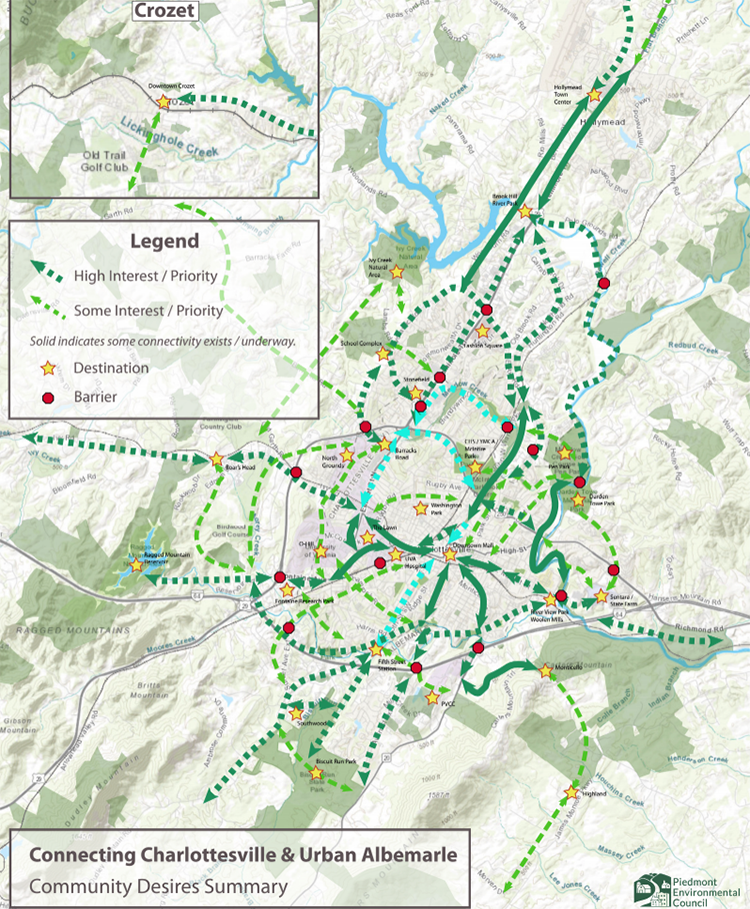Greenways are safe and durable routes where people can walk, bike and run in nature-rich settings. For more than a year now, PEC has been working with the Thomas Jefferson Planning District Commission (TJPDC) to link communities in the Charlottesville/Albemarle urban core with greenways and other infrastructure for walking and biking, both for transportation and recreation.
High-quality greenways benefit residents and communities in a myriad of ways. Additionally, they improve the environment and make the community more appealing, prosperous and attractive to investment.
Not only do greenways make life better for urban commuters and others, they also provide urban residents with the kind of outdoor access to nature that so many people crave. Making better urban areas encourages development in designated growth areas. And that helps reduce the pressure to develop in the rural countryside.
TJPDC’s Jefferson Area Bicycle and Pedestrian Plan, which is expected to be approved by this March, is an important milestone in our partnership. This Plan covers Charlottesville and Albemarle, Fluvanna, Greene, Louisa and Nelson counties, with a heavy focus on the combined Charlottesville/Albemarle urban core. It lays out a comprehensive network of on-and-off-street infrastructure, including sidewalks, urban bike lanes and routes, shared-use paths (aka greenways) and rural bike routes. The Plan also designates priority corridors and recommends ways for the city and county to work together to connect residents to jobs, shopping, healthcare, education and other resources. Once adopted, it will guide future transportation and land use decisions.

We conducted intensive community engagement to gather data and input for the Plan and to mobilize and coordinate public support for its implementation. Hosting and attending more than 300 meetings and gatherings collectively, we met with a diverse group of residents in community centers, parks, businesses, classrooms, art spaces, restaurants and even on the sidewalks!
In addition to our focus groups, discussions, map exercises and many other ways of hearing from residents, we created a survey that asked about walking, biking and running in the area. Respondents were invited to identify barriers and limitations, envision ideal conditions and make concrete suggestions for a better connected community. Of 857 responses, the majority indicated concerns about automobile-related injury limit their ability to walk and bike for both transportation and exercise.
Among other findings, both men and women prefer to walk, bike and run in nature-rich environments, but many women have additional concerns about personal safety and prefer to be in spaces with other people around. Participants desired easier access to practical destinations like jobs and shopping, but also expressed strong affinity for parks and natural areas.
These results suggest that bike and pedestrian corridors must be protected from automobiles, and designed for personal safety, sociability and easy access to nature, while linking places where people live, work and play.
Of course, a plan is only the first step. Implementation requires several additional ingredients, funding not the least among them. We have been calling for local governments to make connectivity a priority and Albemarle is responding with $6 million in proposed new bike/pedestrian spending and a new position to oversee greenways planning. This is great news! Meanwhile, we are working with the City of Charlottesville to increase their ongoing commitment. Private and foundation donors will need to step up to the plate as well. All of this comes down to the will of the public, which is why organized mobilization is so essential.
We will continue to act as a catalyst and keep you updated as we move forward. In the meantime, you can learn more about the survey, the Jefferson Area Bike and Pedestrian Plan and how you can be a part of our growing coalition for a safe and connected community by visiting www.pecva.org/cvillegreenways or by contacting Peter Krebs at pkrebs@pecva.org or calling (434) 977-2033 ext. 7065.
This article was featured in our Spring 2019 member newsletter, The Piedmont View.
